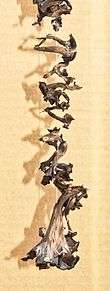Craterellus cornucopioides
| Craterellus cornucopioides | |
|---|---|
 | |
| Scientific classification | |
| Kingdom: | Fungi |
| Division: | Basidiomycota |
| Class: | Agaricomycetes |
| Order: | Cantharellales |
| Family: | Cantharellaceae |
| Genus: | Craterellus |
| Species: | C. cornucopioides |
| Binomial name | |
| Craterellus cornucopioides (L.) Pers. | |
| Craterellus cornucopioides | |
|---|---|
|
| |
| ridges on hymenium | |
| cap is infundibuliform | |
| hymenium is decurrent | |
| stipe is bare | |
|
spore print is cream to buff | |
| ecology is saprotrophic | |
| edibility: choice | |
Craterellus cornucopioides, or horn of plenty, is an edible mushroom. It can also be known as the black chanterelle, black trumpet, trompette de la mort (French), trombetta dei morti (Italian) or trumpet of the dead.
The Cornucopia, in Greek mythology, referred to the magnificent horn of the nymph Amalthea's goat (or of herself in goat form), that filled itself with whatever meat or drink its owner requested. It has become the symbol of plenty.
A possible origin for the name "trumpet of the dead" is that the growing mushrooms were seen as being played as trumpets by dead people under the ground.
Description
The fruiting body does not have a separation into stalk and cap, but is shaped like a funnel expanded at the top, normally up to about 10 cm (4 in) tall and 7 cm (3 in) in diameter[1][2] (but said to grow exceptionally to 15 cm (6 in)[3][4]). The upper/inner surface is black or dark grey and the lower/outer fertile surface is a much lighter shade of grey. The fertile surface is more or less smooth but may be somewhat wrinkled.
The size of the elliptical spores is in the range 10-17 µm × 6-11 µm. The basidia are 2-spored.

Distribution and habitat
This fungus is found in woods in North America, Europe, Japan and Korea.[5] Mainly it grows under beech, oak or other broad-leaved trees, especially in moss in moist spots on heavy calcareous soil.[3][4] In Europe it is generally common but seems to be rare in some countries such as the Netherlands. It appears from June to November,[2] and in the UK, from August to November.
The mushroom is usually almost black, and it is hard to find because of its dark colour, which easily blends in with the leaf litter on the forest floor. Hunters of this mushroom say it is like looking for black holes in the ground.[6]
Related species
_Qu%C3%A9l_100703_cropped.jpg)
Craterellus cornucopioides has a smooth spore-bearing surface, but the rare and not very closely related Cantharellus cinereus has rudimentary gills.[3] The colour and smooth undersurface make C. cornucopioides very distinctive.
The forms Craterellus fallax (with a different spore colour en masse) and Craterellus konradii (with a yellowish fruiting body) have been defined as separate species, but DNA studies now show that the latter should be considered part of C. cornucopioides [7][8]
Edibility

Horns of plenty are edible and sought after. According to a Portuguese study, 100 grams of dried C. cornucopioides contain 69.45g of protein, 13.44g of carbohydrates (mostly mannitol, a sugar alcohol) and 4.88g of fat, amounting to 378 calories. They contain fatty acids, primarily of the polyunsaturated variety, as well as phenols, flavonoids and 87 mg of vitamin C.[9]
They look rather unattractive, but have a very good flavour.[4] When dried their flavour even improves, acquiring black truffle notes.
One French cook-book specializing in mushrooms has eight different recipes for this one species (terrine, soufflé, marinade, tajine, fricassée, ...) [10]
References
- ↑ Roger Phillips: Mushrooms and other fungi of Great Britain & Europe (1981), Pan Books Ltd., London.
- 1 2 Courtecuisse, R. & Duhem, B. (1994) "Guide des champignons de France et d'Europe" Delachaux et Niestlé, ISBN 2-603-00953-2, also available in English.
- 1 2 3 Marcel Bon: The Mushrooms and Toadstools of Britain and North-Western Europe Hodder & Stoughton ISBN 0-340-39935-X.
- 1 2 3 Courtecuisse, Régis (1999) "Collins Guide to the Mushrooms of Britain and Europe" HarperCollins, London ISBN 0-00-220012-0.
- ↑ See the entry in the Global Biodiversity Information Facility.
- ↑ Kuo, M. (2006, February). Craterellus cornucopioides. See the MushroomExpert.Com article.
- ↑ Kuo, M. (2003, June). The Cantharellus/Craterellus clade. Retrieved from the MushroomExpert.Com Web site:
- ↑ Matheny, Patrick Brandon; Austin, Emily A.; Birkebak, Joshua M.; Wolfenbarger, Aaron D. (3 July 2010). "Craterellus fallax, a Black Trumpet mushroom from eastern North America with a broad host range" (PDF). Mycorrhiza. 20 (8): 569–575. doi:10.1007/s00572-010-0326-2. Retrieved 5 October 2014.
- ↑ Barros, Lillian; Telma Cruz; Paula Baptista; Leticia M. Estevinho; Isabel C.F.R. Ferreira (February 2008). "Wild and commercial mushrooms as source of nutrients and nutraceuticals" (PDF). Food and Chemical Toxicology (46): 6.
- ↑ Frédéric Jaunault & Jean-Luc Brillet (1998). Toutes les bases de la cuisine aux champignons (in French). Rennes: Editions Ouest-France. p. 84. ISBN 2-7373-2275-8.
External links
| Wikimedia Commons has media related to Craterellus cornucopioides. |
- Craterellus cornucopioides in Index Fungorum
- Mushroom-collecting.com: Craterellus cornucopioides
- MykoWeb California Fungi: Craterellus cornucopioides
- Craterellus cornucopioides Healing-Mushrooms.net, March 2008.